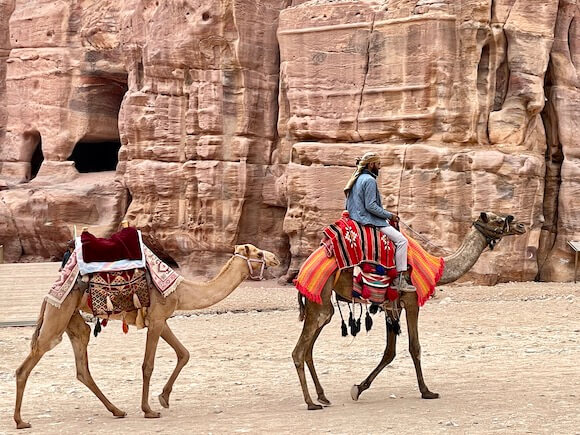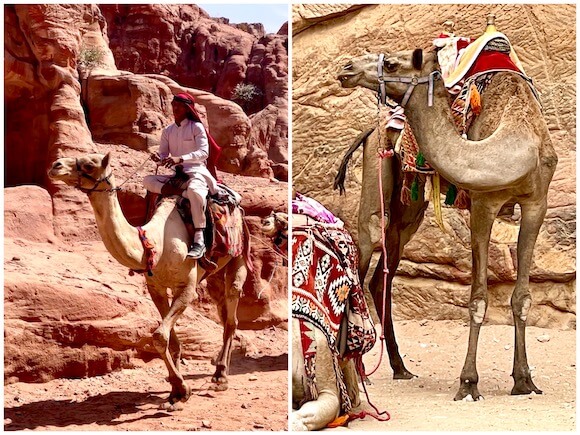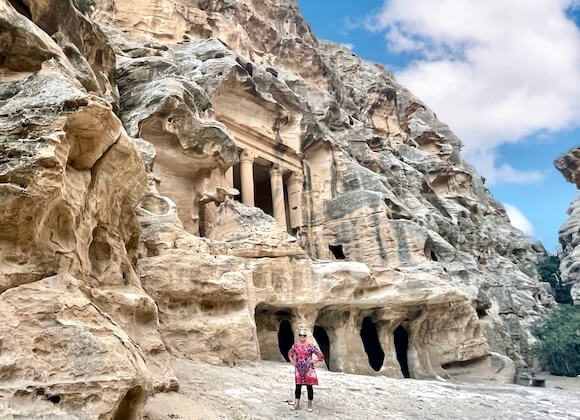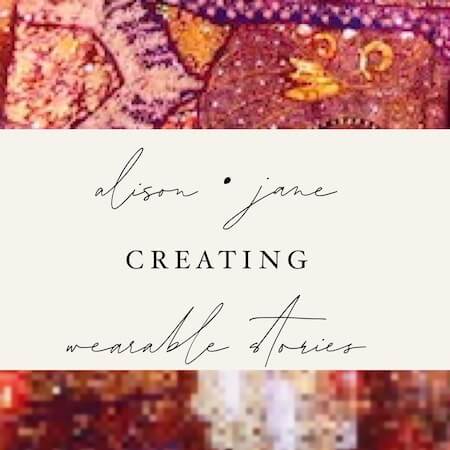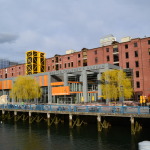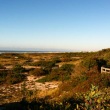Inside Petra Jordan’s Rose City
Exploring inside Petra has been a bucket list goal for as long as I can remember. For some, the City of Petra is unfamiliar – but for history buffs and fans of Indiana Jones and The Lost Crusade, images of Petra will be instantly recognizable. This stunning ruin, carved into sandstone is hidden in a valley, surrounded by mountains.

Petra is a wonder of the world that will leave you speechless as you marvel at the astonishing carvings. In 1985 it was recognized as a UNESCO World Heritage Site. The infamous movie in 1989 put the Rose City on the map of international tourism.
Take a journey with me. The confluence of culture, archeology and natural wonder awaits inside Petra. Learn a little more about how it came to be and discover how best to experience it.
Tip: The journey to Jordan can be long, so take advantage of a luxury layover in Doha if you are flying through Qatar.
Brief History – Who Lived in Petra?
The area around this city has been inhabited since 7,000 BC. Many believe that the Nomadic Arab people, known as the Nabataeans, settled here in the 1st century BC and constructed Petra.
The Nabataeans made this city the capital of their region during the lucrative spice trade era. Through a series of cisterns, canals and dams, they created a remarkable habitat oasis, controlling the flash floods that still race through the area today.
The Romans later defeated the Arabic tribe to take control of and occupy the city. Eventually, the spice trade route changed, and the Romans no longer saw the value of the city. An earthquake in 363 AD further damaged structures. Slowly over the ages the destination fell into disuse and ruin.
The last known inhabitants of the city were soldiers of the Crusades. They used the Petra interior as an outpost. After this, the locale was lost to all except the local Bedouin. Completely unknown to the West until 1812, it was then rediscovered by Johannes Burckhardt, a Swiss explorer.
The Bedouins
Bedouins are a type of nomad who have been traveling the challenging environment of the desert for hundreds of years. The term bedouin simply means desert dweller, and these people have become experts at an existence in a landscape known for its lack of water and barren soil.
During the 14th and 18th centuries, various tribes migrated from the Arabian Peninsula to what is modern day Jordan. Today, while it is difficult to maintain a census of the Bedouin population, estimates put a majority of Jordan’s population as of Bedouin origin.
The Bedouins are most famous for their hospitality. Indeed, their culture maintains that no traveler ever be turned away and visitors will find their welcoming nature everywhere.
Found throughout the south and east of the country, some tribes are still completely nomadic, but many combine raising crops with a nomadic existence. Their characteristic black goat hair tents, known as beit-al-sha’ar, can be seen off the highway tucked into the dunes on the road to Petra.
Relocating the Bedouins Inside Petra
The Bedouin of Petra are known as the B’doule. As part of the Huwaitat tribe, they are thought to be direct descendants of the Nabataeans. Visitors will immediately recognize them by the dark kohl outlining their eyes and distinctive dress.
As visitor interest to Petra increased, the Jordanian government decided to relocate the Bedouins still living in Petra’s caves and tombs. A village was built nearby and the nomads reluctantly moved to their new housing. Many are still connected to the historical site and come to Petra daily for the tourist trade, selling traditional crafts, refreshments and donkey and camel rides to visitor caravans. The modern-day version of trading and bargaining continues.
There appears to be a swing in the government policy which now recognizes the value of the Bedouin contribution to Jordan’s culture and heritage. While change does not come easy, the government provides education, housing and access to health clinics. The phase is transitional, and some of the nomads continue to live in the lifestyle that has been such a part of their life for hundreds of years.
Where is Petra?
The ruins of the ancient city known as Petra are in the southwest area of Jordan. Located in the southern province of Ma’an, it is not far from the Israeli border.
The astonishing city was built on a terrace. Inside, the Wadi Musa, or valley of Moses, cuts a slot cavern and runs from east to west. Shades of rose and purple cover the sandstone cliffs surrounding the city giving it the nickname of The Rose City.
How to get to Petra
Once you are in Jordan, there are several main areas from which to make your journey to Petra. I was on a tour with G-Adventures – Highlights of Jordan, and the visit to Petra was include in the itinerary. In fact, it was the main event!
We traveled there from Amman with stops along the route. It’s approximately 3 hours (direct) from the capital via the Desert Highway and 4.5 along the more scenic, but slower King’s Highway.
If you’re staying in Wadi Musa, Petra is just a short distance away. Hotels further out can arrange the free shuttle that goes to the visitor center. There are also plenty of taxis which will run about 5JOD.
The coastal resort town of Aqaba is approximately 2 hours away. For public transportation investigate the JETT buses to all major points.
While spending a night or two in Wadi Musa is the best way to see this fascinating UNESCO World Heritage site, there are day trips available from Amman, Aqaba, and Israel. When in this area of the Middle East, you don’t want to miss the magical mystery tour inside Petra.
Inside of Petra Jordan
The Visitor Center is your point of entry to the magnificent Petra interior.
While the city of Petra looks nothing like the Wonder of the World it was in its heyday, I guarantee visitors will still find the remains magnificent.
The enduring carvings and facades easily allow your imagination to run wild to the days when the bustling city was an important and prosperous empire of trade. This incredible historical and cultural site was voted one of the New Seven Wonders of the World in 2007.
What is inside of Petra? Let’s take a look.
Map of Route Inside Petra

Map of Petra’s interior
The Djinn Blocks
If you make a run for the Siq, you might miss the Djinn blocks which are between the Siq’s entrance and the visitor center. Apparently, these giant cubes are tombs with the name “Djinn” translating to ghost, a reference to their use.
There are three Djinn blocks here, but six exist in the Petra region. They are believed to be from around the 2nd century BC, some of the oldest ruins and monuments within the city.
The Bab as-Siq of Petra
Serving as the grand entrance and gate to the City of Petra, this pathway takes you into the Valley of Petra through a gorge.

Just coming to the infamous entry to the Treasury through the slot canyon.
The best part of the Siq is right at the end of the passage when the sides of the gorge seem like they stretch far into the sky as they tower over you. When you get to the end, you will see the light hitting the entrance of the Treasury. This is one of those goosebump moments that will stop anyone in their tracks.
Inside Al Khazna aka the Treasury
If there were ever a picture of Petra that made it instantly recognizable, a photograph of the Treasury would be it. The energy around this building is quite mystical, drawing people in with the exquisite detail of the Al Kahzneh.
This also happens to be the most popular attraction in the region and is actually a temple, thought to be a monument to King Aretas IV of the Nabateans. It only became known as the treasury by the Bedouins as they believed the area contained immense treasures.
Unfortunately, you won’t be able to go inside the Petra treasury as it’s not safe. But you won’t be missing much as it’s just an empty chamber now. The outer design is the attraction.
The Instagram Moment Inside Petra
If you are looking to get one of the best shots of the Treasury and the covetable picture from above, there are several options. At you enter from The Siq and are standing in front of the Treasury, you will find an area to the right with a makeshift staircase leading to a ledge above. It is illegal to climb on your own and do not attempt it unless you have good treads on your shoes.
There are several bedouins who will offer to take you up for a fee. My knowledgeable guide worked out the details and up I went for a cost of 3JOD. It was a bit hairy in spots, and the guides are “off” to the top like a gazelle right away. Be prepared for a few challenging climbing moments as you make your way up. The reward is worth every harrowing moment.
The Street of Facades
The monumental Nabataean tombs carved in the southern cliff face past the Treasury is known as the Street of Facades. Look for the decorative plasters and crow steps crowning the tombs.
The Theater of Petra
This stunning theater has been carved out of the mountain and held over 8,500 people. It had amazing acoustics and was positioned to show the audience as many of the tombs as possible, from a single vantage point. This is because the Nabataeans chose to live and showcase any special occasion so their dead could witness it.
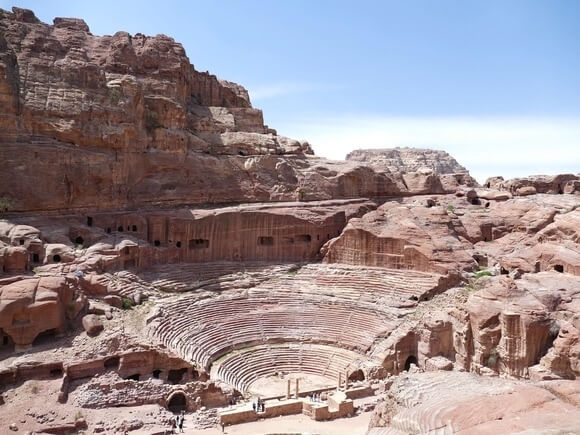
Image by Falco on Pixabay – Amphitheater/Theater
The theater was constructed at the direction of King Arera IV, around 9BC. This was during the period when most of the civil construction took place. Imagine what could have been on show here.
The Royal Tombs Inside the City of Petra
Perched at the top of the east range of cliffs that overlook Petra sits the Royal Tombs. These are large monuments with different facades that are crafted into the mountain face.

The Royal Tombs inside Petra
Although they can’t be linked to any of the leaders of the Nabateans specifically, recent evidence does suggest a royal link.
I highly recommend heading to the Urn Tomb, with its two-story design. It has a large courtyard out front, where you will be treated to some breathtaking views of the city. Other tombs of note are the Silk, Corinthian and Palace tombs. Each is celebrated for its unique characteristics and architectural style.
The Nymphaeum
At the junction of Wadi Musa and Wadi Al-Mataha, keep your eyes peeled for small stack of blocks. This semi-circular ruin, shaded by a wild pistachio tree, was the sight of a grand public fountain. Originally decorated with six Nabataean columns, residents would refresh at the spot as they made their way down the Colonnaded Street. Even the tree is ancient–over 450 years old.
The Church
The church is most probably a ruin from the end of the 5th century AD. As an early example of an upcycled building, many of the components were reused from earlier monuments. Mosaics on the floor of the church are well preserved and indicate by their beauty and complexity the importance of the structure.
Colonnaded Street of Interior Petra
This street was once the heart of Petra, a commercial hub where a large amount of shopping took place. It was lined with different types of vendors and was one of the most important retail areas of Petra.
Image by Chiem Seherin on Pixabay – Colonnaded Street
This stretch of cobblestone served as the main road for over six centuries, stretching from the theater to the Qasr al-Bint Temple. Make sure you stop at the entrance to Colonnaded Street. There is a juniper tree there that is believed to be around 450 years old.
Petra Great Temple
Petra’s Great Temple is unlike any other found in Jordan. This immense complex is south of Colonnaded Street and it is actually unclear if this was used for religious reasons or if it served as more of an administrative function. Visitors can not go inside Petra temples.
Image from Deposit photos – Great Temple
The general consensus though is that this key site was built as a royal reception hall. It was continuously expanded and decorated over the centuries with additional influences from the Romans.
Qasr al-Bint
This important temple dates to the first half of the 1st century AD. Dedicated to Dushara, is a pre-Islamic Arabian god worshipped by the Nabataeans at Petra. Dushara was expected to bring justice if called by the correct ritual ceremony.
The Lion Triclinium
On the way to the Monastery, make sure not to miss the Lion Triclinium. Named for the lions carved on both sides of the entrance, an interesting detail is the head of Medusa which sits atop each end of an additional carving.
Ad Deir – Monastery
This is the pinch me moment-is it all a dream? If I had to pick a favorite spot in Petra, it would hands down be the Monastery. Located in a remote spot high in the hills, Ad Deir takes your breath away when you come upon its façade. Similar in style, but much larger than the Treasury, it was carved from the rock in the 3rd century BC. The setting so natural, visitors see it emerging from the rockface as if it has always been there.
The interior suggests that the building was used for rituals and perhaps banquets in homage to the Nabataean King Obodas II. Ad Dier derives its Monastery moniker from the crosses carved on the inside walls; possibly it was used as a Byzantine church.
If you haven’t had enough climbing, continue to the rocks above, at the end of the western cliffs, which offer incredible panoramas of the Wadi Araba, Israel and the Palestinian Territories.
The monastery, ad-Deir, is actually more of a monument to highlight the temple and is the second most-visited ruin of the city.

Taking a donkey up to the Monastery and walking down to enjoy the view.
I fancy myself as someone in pretty good shape but opted to ride a donkey up the 900 steps to the top. They are surefooted and the flights of stairs unevenly carved into the rock are steep and challenging. Donkeys (see below) can be hired from the local Bedouins for approx. $10 one way (depending on your negotiating skills).
Atop the hill sits a nice café where you can relax, enjoy the view and refresh before making your way back down to continue exploring. Walk down at your own pace (rather than taking the donkey) when you’re finished. It will give you the chance to take in the scenery and photograph the pics you missed holding on for dear life on the ride up.
Animals in Petra
Visitors will find donkey and camel handlers throughout the site. They are an alternative if you decide you’ve had enough hiking. Prices are always negotiable. Look for animals that appear well fed and cared for.
There are signs everywhere to report any mistreating of animals and the charity PETA runs a clinic where you can make a report of any abuse you see. Take a photo and stop at the clinic to make a statement.
As you are leaving the site, you will be approached to take a horse ride out of the city. Tempting for sure if you’ve spent the day hiking in the sun. I was told the price is included with your ticket, the handlers will expect a tip. Just make sure you are clear about price before mounting.
Petra By Night
Once you start researching Petra, there’s no doubt you’ll come across some seductive photos of Petra by Night. This is an additional event outside of your entrance fee visit inside Petra. Many people ask is it worth going to this candle lit event with traditional music.
To be honest, I did not attend. Most people I asked discouraged me. That being said, I think it all depends on what you are looking for. I had spent the entire day at the site, beginning at 6:30 am and was honestly “spent”, with an early departure for Aqaba the next morning. Sorry I can’t guide you here. Depending on your circumstances and arrival time, it’s your call.
Little Petra
My first deep dive into a slot canyon hike and a prelude to the main event, Little Petra is a small taste, but no less captivating archeological site a few miles from its bigger relative. The structures and mountainous landscape appear like a suburb with much of the same style rock cut architecture.
Siq al-Barid is located in a short high gorge about five miles north of the town of Wadi Musa. It receives much less traffic than Petra and gives an opportunity to take in the carved facades and sandstone canyon in a more relaxed atmosphere.
Deep dramatic walls of Siq al-Barid will still take your breath away as they lead you around the canyons. Your imagination will begin to travel back to the days of ancient trade along the silk route. I’d recommend a sunset visit before your early morning arrival at Petra. Don’t miss it!
Petra FAQS, Travel Tips and Important Information
Should you Hire a Travel Guide to visit Inside Petra?
I could not have been happier that I had the wonderful guide from GAdventures, Montaser Khatabeh with us. His knowledge was invaluable. There is very little signage on the site, so unless you bring a guidebook with you, information is scarce.
Monty was also helpful with negotiating with the Bedouins on my donkey ride up to the Monastery and visit to the ledge above the Treasury. After an initial tour, I was left to explore on my own for several hours which was a perfect way to get around to all the spots I wanted to visit.
Best Time of Day to Visit
If you only have one day to visit, I would highly recommend arriving at Petra when it opens at 6am. This was our strategy and it allowed us to get into The Treasury and get great pictures before the mass of tourists. The site can falsely look quite small on the map, but stretches for miles across dusty riverbeds and up mountains.
Without hiking any of the additional trails, and there are many, I clocked in over 24,000 steps on my FITBIT. There is a big advantage to starting the day in the cooler temperatures before the sun comes up. Plus you will see the sun rise above the canyons. Priceless….
How much does it cost Jordan Pass
If you’re going to be visiting other sites in Jordan, you can get a Jordan Pass which includes entry to Petra plus 40 other sites and museums around the country, including Jerash, Amman Citadel and Wadi Rum.
The passes costs 70JOD for one day entry to Petra, 75JOD for two days or 80JOD for three days, and you can buy them online. A one day pass to visit Petra alone is 50JOD, so the pass is a good deal if you are not on a tour. Check the current cost of visiting Petra for the most up to date information.
Restroom Facilities Inside Petra
Petra is well-equipped with toilets. Make a pit stop at the visitor center before you begin exploring. I was very pleasantly surprised by the on-site facilities stationed throughout. Some are staffed with attendants, so bring some small change and some tissues.
What to Wear in Petra
Most important are a sturdy pair of walking shoes. The ground is sandy and rocky and you’ll be walking miles. Jordan is a Muslim country and to respect the culture, I would suggest dressing modestly. Loose fitting clothing for the heat is best. You don’t need to cover your head, although I would strongly advise bringing a hat for the sun. There is very little shade, so make sure to bring sunglasses and sunblock. A light layer for early morning or evening exploring would be useful.
Dehydration
Bottled water is widely available at stalls in and outside the site. When traveling, it’s always a good idea to bring a refillable water bottle with a purification system so you can fill up with tap water. This will save money and to cut down on *plastic waste, a problem for destinations around the world. You will expend a lot of energy in the heat, so make sure to stay hydrated.
When to Visit the Ruins of Petra
The best months for good weather in Petra are March, April, May, June, July, August, September, October and November. I visited in October and it was plenty warm, usually in the 80°, but I needed a shawl when the sun went down. On average, the warmest months are June, July, August and September
Petra has dry periods in April, May, June, July, August, September and December. There are only an average to 22 days of rain a year. January is the coldest month of the year with lows reaching close to freezing in the north.
Souvenirs
There are souvenir stalls all over Petra (and sellers can be agressive). One stop to look out for is the jewelry stall run by New Zealander Marguerite van Geldermalsen. It is located near the museum. She came to Jordan as a backpacker in the 1970s and ended up marrying a Bedouin. If you’re curious about cave life in Petra, I would recommend a book she’s written about her experience-good pretrip insight– Married to a Bedouin.
There are several vendors in front of the royal tombs. One interesting character is the owner of a small stall selling frankincense, myrrh and other organic substances. The trade of these substances was very lucrative in the ancient world. Both were used to make incense which was burned as an offering in all the temples and used in herbal science. Frankincense is thought to drive away evil spirits and in biblical times was worth more than gold. The owner is happy to have you sample and many organic oils are great gifts to bring home.
Final Thoughts on Visiting Inside Petra
If I could leave you with a final thought, it is my hope that you will be inspired to visit this remarkable Wonder of the World. A trip inside Petra should be on everyone’s bucket list. It is hard to convey just how incredible this place is and the feelings that it can evoke when you walk along with these ancient carvings.
The site will fill you with awe and wonder, no doubt exceeding all of your expectations like it did mine!
This trip is up there with my sacred valley experiences of Peru. After a taste of the country’s renowned hospitality and wonder, I have no doubt it will leave you wanting more.
Wait… Discover More About Jordan
The Best things to do in Jordan
Arabic Street Food Flavors of Jordan
Pin and Save For Later ♥ Guide to Inside Petra Jordan
Disclosure: The author partnered with GAdventures, an award winning, responsible travel company, during her travel to Jordan. As always opinions, experiences and thoughts are her own without edit.


